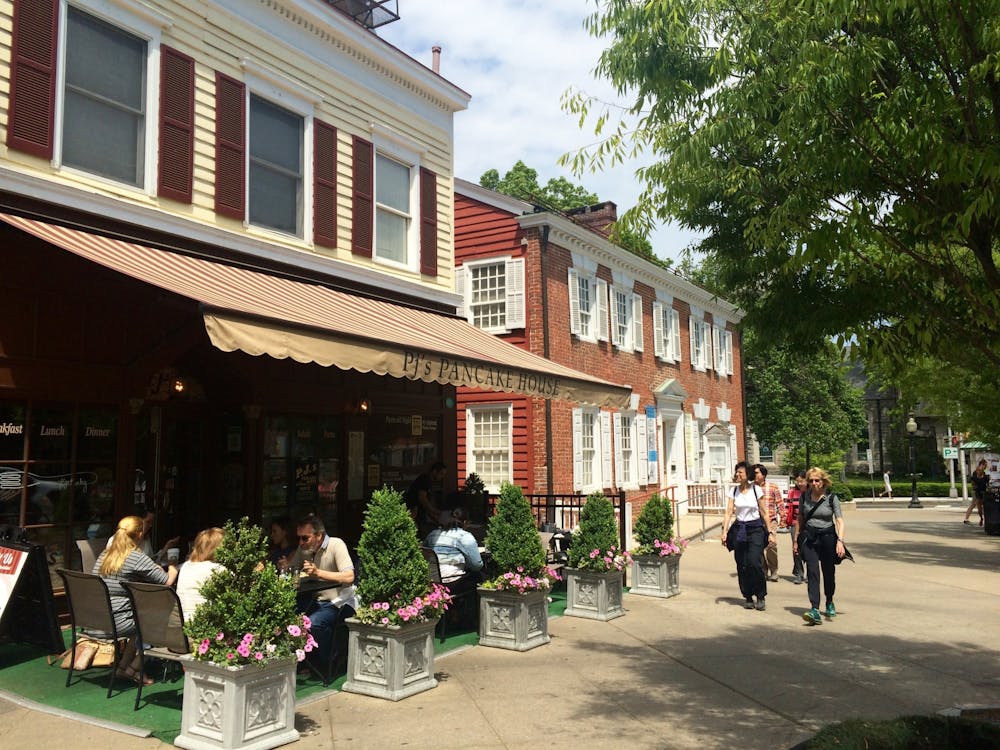The artist is a figure more often associated with starvation than conventional education. Princeton alumni, however, have never found scholarship incompatible with the creative arts.
"My approach to music before coming to [Princeton] was entirely based on feeling and emotion," said Hobart Earle '83, musical director and conductor of the Odessa Philharmonic Orchestra in Ukraine. At the University, he was introduced to the intellectual side of music, gaining a "deeper level of understanding of what's going on in music, how music is put together [and] what makes it work."
Born and raised in Caracas, Venezuela, Earle was exposed to various types of music at an early age. "Because I had two older sisters who came of age in the 60s, I [would hear] Beatles and Simon and Garfunkel," Earle said. He was also exposed to Latin American music, and his mother, a graduate of Westminster Choir College, was the conductor of a church choir in Caracas.
"I saw a lot of my mother rehearsing [with the] choir," Earle said. "I sang a lot too. Before my voice broke, I sang a lot as a boy soprano." Earle also played the clarinet and later took lessons while attending boarding school in Scotland.
"When I came to Princeton, I think it was pretty clear in my mind that I would end up in music," Earle said.
Earle played clarinet for the University Orchestra, and during his senior year became the first student conductor of the University Wind Ensemble. After graduating, he returned to Europe to study at the Academy of Music in Vienna, where he sang with the Vienna Singverein, the foremost amateur choir in Vienna and one of the most well-known in the world.
In 1987, Earle formed his own chamber orchestra, bringing contemporary American music to Vienna and contemporary Viennese music to America. After visiting the Soviet Union in 1990 with his chamber orchestra, Earle was offered the job of permanent conductor of the Odessa Philharmonic Orchestra. He became the first American citizen to conduct an orchestra hailing from the former Soviet Union.
"Back then it was a different world. I came at the time when everything was beginning to open up ... My first concerts with the Odessa Philharmonic were before the end of the Soviet Union, " Earle said. "For many people in that orchestra, I was probably the first American they'd ever seen."

When Earle first took the job, the orchestra's instruments were worn out, and the hall was in need of improvement.
"This is a great orchestra with a great tradition but during [the] Soviet era great aspects [of it] were neglected," Earle said.
Today, Earle has taken the Odessa Philharmonic to a new level. It is the only performing arts company in Ukraine to have gone from regional to federal and finally to national status. The Odessa Philharmonic has seen its fair share of honors over the years. In 2002, the orchestra received the Just Plain Folks Award for Best Classical Album. Earle himself has had a star named after him by the Russian Cosmonaut association.
"For the past 15 years, I have been focused on building that orchestra," Earle said. "[It] has a kind of stability that it hasn't had before."

For those looking to follow a similar career path, Earle offers the following advice: "Try and get as much broad musical knowledge as possible [and] try and attend orchestra rehearsals ... and obviously, if you can, playing in an orchestra is very good."
Those more interested in dance may find something of an exemplar in Jose Mateo '74, founder, artistic director and choreographer of Jose Mateo's Ballet Theatre in Cambridge, Mass.
Mateo was born in Cuba and lived there for five years before his family moved to New York. "I think I was raised on all types of music," Mateo said. "Of course there was the American pop music. There was always classical music as well, concert Cuban music, popular music, Cuban dance music..."
Dance was an intrinsic part of the culture in Cuba, Mateo said, and would continue to be a vital part of his life even after he had moved to the United States.
"I've always been drawn to all forms of dance," Mateo said. "Coming to Princeton was [my] first exposure to actual training."
When he arrived at Princeton, in addition to signing up for ballet classes at a local studio, Mateo enrolled in one of the University's brand new modern dance classes.
"It had an impressive amount of men," he said.
An art history major, Mateo said he has always had an interest in art and culture.
"[Art] always seemed to be a preferable way to understand history by looking at artistic and cultural revolution rather than military history and political history," he said. The revolutionary artists of the late nineteenth and early twentieth century had a profound influence on Mateo's approach to dance.
"Most ballet is still produced in the late 19th-century style ... [and] they almost promote the stereotypical aloofness of the ballet dancer and basically remove themselves from the audience," Mateo said. His work, on the other hand, "has tried to interact with the viewer and really challenge the role of the spectator."
After college, Mateo moved to New York, where he trained and worked with a number of companies. He resisted teaching until he moved to Boston in 1981, and eventually started his own nonprofit ballet company and school in Massachusetts in 1986. Through his work, Mateo hopes to bring the old art form into the modern era.
"I think most artists are concerned with expressing what's going on in his or her place and time," Mateo said. "This is one of the ways in which ballet was behind ... always recreating old work and building exclusive audiences."
Through his choreography, Mateo aims to adhere to the principles of classicism while expressing contemporary and personal ideas.
"The last ballet I choreographed, which was the direct result of some traveling I'd done to Poland, was very personal and even religious in some ways," he said. "[It was] my reflection of the deep religiosity of the particular culture at this point in time in its history."
Mateo estimates that he has choreographed over 50 pieces for his company and 25 more for young dancers in school and public presentations.
"In most schools, [young dancers] are asked to perform roles choreographed for more seasoned dancers," he said. "I've tried to provide opportunities for younger people to display their talent in customized pieces."
For those looking to pursue a career in dance, Mateo suggests gathering as much information as possible about the industry, which can present some harsh realities.
"Persevere, because it's always going to be [full of strife]," he said. "The conditions are never ideal and they're never comfortable but the gratification can be substantial."







